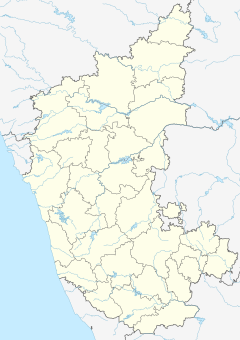
Walkeshwar Temple, also known as the Baan Ganga Temple, is a temple dedicated to Lord Shiva located in Walkeshwar, near Malabar Hill neighbourhood, in South Mumbai precinct of the city of Mumbai, India. It is situated at the highest point of the city, and close to the temple lies the Banganga Tank.

Sree Venugopla Krishna Swami Devasthan is a Hindu temple located in Chendamangalam, Kerala, India. It was established in 1900 at Chendamangalam, 42 km from Ernakulam, 22 km from Aluva and 5 km from North Paravur.

Sivagiri is an area in Varkala Municipality of Thiruvananthapuram district in Kerala. It is a pilgrimage centre of Varkala Town where the tomb, or samadhi, of Sree Narayana Guru is situated. It is a place where Guru built the Sarada Temple dedicated to Sarada Devi. The tomb is an attraction for thousands of devotees every year, especially during the Sivagiri Pilgrimage days from 30 December to 1 January.

Kashi Math is a matha (monastery) and a spiritual organisation followed by the Madhva section of Gaud Saraswat Brahmins, who are also referred as Madhwa Saraswat Brahmins or Vaishnava Saraswat Brahmins. It dates back to the 16th century. With its headquarters in Brahma Ghat, Varanasi. Kashi Math has followers all over the Konkan belt, prominently in Mumbai, Goa, Udupi, Mangalore, Kochi and other parts of Karnataka and Kerala.
Gaud Saraswat Brahmins (GSB), also known as Shenvis are a Hindu community of contested caste status and identity. They primarily speak Konkani and its various dialects as their mother tongue.
The Maha Ganapathi Mahammaya Temple is a Hindu temple in Shirali in the Uttar Kannada district of Karnataka state. The temple is dedicated to the god Ganesha as Mahaganapati and the goddess Mahamaya (Shantadurga). The temple is the Kuladevata Temple of the Goud Saraswat Brahmin community. The temple god is a Kuladevata of the Kamaths, Bhats, Puraniks, Prabhus, Joishys, Mallyas, Kudvas and Nayak families from the Goud Saraswat Brahmin community. The Temple was built about 400 years ago. It was renovated in 1904.

The Ramnathi Temple is located in Ramnathim, Bandivade in Goa. The primary worshippers come from the social classes Goud Saraswat Brahmins (GSB) belonging to Gokarn Math, & Kashi Mutt, Daivadnya Brahmin and Vaishyas. Similar to other Goan Brahmin temples, Ramnathi too incorporates the system of Panchayatan, therefore, this temple houses 5 main deities namely; Shri Ramnath, Shanteri, Kamakshi, Laxmi Narayan, Ganapati, Betal and Kalbhairav, along with other family purushas.
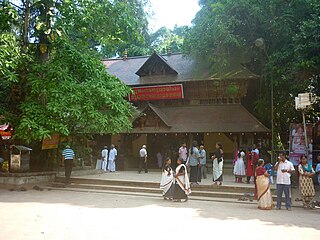
Mannarasala Sree Nagaraja Temple in Haripad is a very ancient and internationally known centre of pilgrimage for the devotees of serpent Gods (Nagaraja). The famous Nagaraja temple "Mannarasala" in Haripad is nestled in a forest glade, like most snake temples. The Mannarasala Temple has over 100,000 images of snakes along the paths and among the trees, and is the largest such temple in Kerala, India. Couples seeking fertility come to worship here, and upon the birth of their child come to hold thanksgiving ceremonies here, often bringing new snake images as offerings. A special turmeric paste which is available at the temple is credited with curative powers.
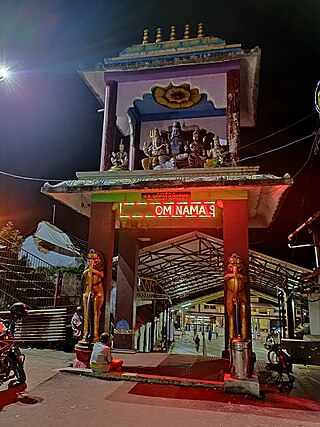
Sri Visalakshi Sametha Sri Viswanatha Swamy temple, popularly known as Kasi Viswanathaswamy Temple, or locally as kundukovil, is a famous Hindu temple located in the Kalpathy village of Palakkad in Kerala, India. It is the site of the annual Kalpathi Ratholsavam which is one of the most famous temple festivals of Kerala. This ancient temple nestles by the banks of the serene Kalpathy river. Dedicate to Lord Siva and his consort Visalakshi, it dates back to early fifteenth century. The similarity to the Varanasi Kashi Viswanatha temple on the banks of Ganges is responsible for the moniker kasiyil pakuthi kalpathy and the name Dakshina Kashi associated with this temple. The Temple is surrounded by the four Tamil Brahmin agraharams or traditional villages: New Kalpathy, Old Kalpathy, Chathapuram and Govindarajapuram.
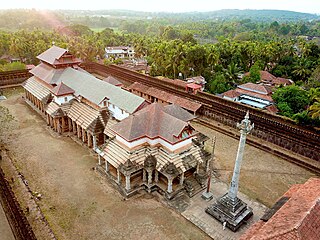
Moodubidire is a town and taluk in Dakshina Kannada district. It lies 34 km northeast of the district headquarters, Mangalore, in Karnataka, India.

Vaikhanasa or Vaikhanasagama is a tradition of Hinduism that primarily worships Vishnu as the Supreme God. The tradition draws its name from the philosophy propounded by its founder, Sage Vikhanasa.
Tirumala Krishna idol is one of the idols in the Tirumala Venkateswara Temple, Andhra Pradesh, India. While the temple is dedicated to worship of lord Vishnu as Venkateswara, it contains the idols of some of Vishnu's other avatars - Krishna and Rama. The temple also has the idol of Rukmini, wife of Lord Krishna.

Karkala is a town and the headquarters of eponymous Karkala taluk in the Udupi district of Karnataka state in India. It lies near the foothills of the Western Ghats, Karkala has a number of natural and historical landmarks, and is a major tourist and transit destination due to its strategic location along the way to Hebri, Sringeri, Kalasa, Horanadu, Udupi, Kollur, Subrahmanya and Dharmasthala.
The Sree Balakrishna Swamy Temple, Kuzhuppilly of Goud Saraswat Brahmin (G.S.B.) community is in Kuzhuppilly village, Vypeen Island, Ernakulam district, Kerala, India. The temple in the present form was completed in 1964 A.D.
Sree Venu Gopala Swamy Temple, Purakkad is one of the oldest Gowda Saraswath temples in the world. The main deity is Sree Venu Gopala Swamy. Located in the ancient port city of Purakkad, in Alappuzha the temple was built around 400 years back. Gowda Saraswath Brahmin devotees from all over the world bring their children to perform "Devak Deevop" and "Sodovop".

Thuravoor is a gram panchayat in the Pattanakkad Block of Cherthala Taluk of the Alappuzha District, State of Kerala, India. It comes under Aroor Assembly constituency. Thuravoor lies under Kochi UA in future. A four lane(six lane is progressing) National Highway 66 passes through the village, which along with a railway station gives it excellent connectivity with the remainder of the state. The new 6 lane elevated highway is from Thuravoor to Aroor. Upon completion, it will become the longest elevated highway in the country. Thuravoor is a rapid developing town. It lies in Aroor Assembly constituency. Thuravoor Kumbalangi road is a main road parallel to NH 66. Thuravoor is the major entry to Kochi city.
Shri Katyayani Baneshwar Temple ,(Sanskrit:श्री क़ात्यायनी बाणेश्व् र मन्दिर), or the Aversa Hindu Narayani is a Hindu temple in the coastal town of Aversa near Ankola, in the Uttara Kannada district of Karnataka. It is around 100 km (62 mi) from Goa, India, 500 km (310 mi) from Bangalore and 136 km from Hubli.
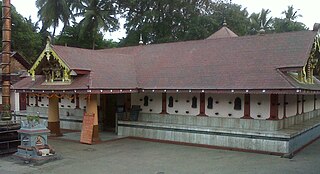
Sri Lakshmi Narasimha Temple is a Hindu temple associated with Gowda Saraswatha Brahmins (GSB) in and around Thalassery.

Cochin Tirumala Devaswom, also called Gosripuram is the biggest and most important socio-religious institution of Gowda Saraswat Brahmins of Kerala, India. The temple is situated at Cherlai in the heart of Mattancherry town in Cochin area which is one of the earliest settlements of GSBs in Kerala. The temple was established in the later half of the 16th century. The history of GSBs in Kerala is inter-woven with that of this temple and its Venkateswara idol.

The Sri Varahaswamy Temple, also called Bhu Varahaswamy Temple, is a Hindu temple dedicated to the god Varaha, situated at hill town of Tirumala in Tirupati, located in Tirupati district of Andhra Pradesh state, India. The temple is situated on the northern premises of Venkateshvara Temple, Tirumala, on the north-west corner of Swami Pushkarini. This temple is believed to be older than the Venkateshvara shrine.

